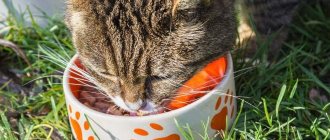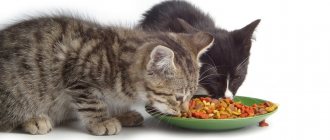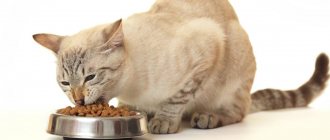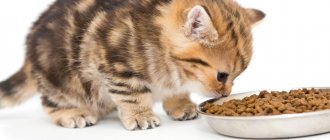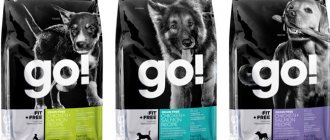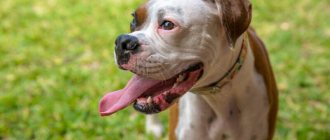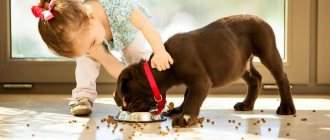You need to approach the choice of diet for your pet responsibly, weighing the pros and cons, taking into account the characteristics of the breed and the state of its health. We have already talked about what is better to feed your dog: dry food or natural food. They also talked about the variety of industrial dry products and told how to choose dry food. Regardless of whether you are going to transition an adult dog to drying or choosing a diet for a newly acquired puppy, there are several rules that are very important for your pet to follow. So, how to feed your dog dry food and how to change the diet so as not to harm the dog’s health?
The need for vitamins
Feeding your pet with dry complete food assumes that it contains all the necessary vitamins and minerals.
Therefore, the risk of vitamin deficiency with such a diet is reduced to zero. Additives need to be taken care of when using economy class food. In this case, you can add multivitamins sold in pet stores or specialty pharmacies. It is important not to overdo it with additives. An excess of any substance in the body can cause hypervitaminosis and even cause death.
Karmy
Owner reviews
Julia, Ufa:
The Perfect Fit food was recommended to us by a veterinarian. My dog liked the diet and eats with appetite. In addition, the dog was overweight, but now we are in good shape thanks to this food, always energetic and healthy. Now we only buy it.
Natalya, Novosibirsk:
Four months ago we picked up a puppy on the street. The question immediately arose: “What to feed?” Homemade food was absolutely not suitable for him, and we couldn’t afford very expensive food. Perfect Fit was a godsend for us - balanced, with a good composition. The dog began to gain weight well, his fur began to shine, and he became more active. There is no repulsive smell from the mouth. A veterinarian I know said that with this food the dog’s teeth will be fine. We have been buying this food for several months now and have no plans to change it yet.
Peculiarities
In some cases, the owner wants to develop his own nutritional formula for the pet. However, do not forget that manufacturers indicate average values. For a particular dog, it is better to organize feeding according to individual standards.
Often, representatives of the same age have different nutritional needs. In addition, you should take into account the conditions of detention, daily routine, and the number of walks.
Puppies
When feeding a small pet, its exact age must be taken into account. It is especially important to contain the required amount of vitamins in the food for the full growth and development of the baby.
Large breeds
Large breed dogs, such as the Black Russian Terrier or Caucasian Shepherd, are prone to obesity, which often leads to heart disease. When choosing food for them, you should pay attention not to the energy value of the feed, but to the quality of the proteins. The high content of vitamins and minerals is especially important.
Small
Small dogs require a higher calorie diet. Breeds such as the Italian Bolognese, Bedlington Terrier, and Prague Ratdog are more active, which means they spend a lot of energy that needs to be replenished.
Wet food
Soft canned food has exactly the same division into classes as dry food. This means that the higher the class of food, the greater its energy and nutritional value, which means that less of it will be needed to saturate.
However, it is not recommended to completely switch the animal to feeding canned foods - soft food can cause problems with the gastrointestinal tract, constipation or loose stools, and the risk of tartar formation increases, since there is no mechanical cleaning of plaque.
| Type of dog | Daily calorie requirement (kcal) | Combined diet (dry + wet) (g) Pedigree | Only wet (100%) (gr) Using Pedigri as an example |
| Miniature (2-5 kg) | 250-350 | 40-50 | 300-400 |
| Small (6-10 kg) | 360-550 | 50-100 | 400-700 |
| Medium (12-24 kg) | 600-1050 | 100-250 | 800-1300 |
| Large (26-40 kg) | 1100-1550 | 200-300 | 1400-2000 |
| Very large (45+ kg) | 1600-2500 | 300-550 | 2050-6000 |
Is it possible to combine drying and natural?
It is not recommended to feed your dog dry food and natural food at the same time, because the intestines will digest different types of food differently. In addition, the dog may subsequently refuse to eat the dry food. Mixing diets is possible in some cases:
Feeding puppies in nurseries. Breeders accustom babies to both types of food, so that in the future they can more easily adapt to what the owner chooses.
Sports dogs and hunting breeds. They need an increased amount of protein, but no more than 30% of the norm. The source can be meat, eggs or cottage cheese.
Breeding males and females. To obtain more nutrients, you can add herbs, meat, cottage cheese, and vegetables to the concentrate.
When combining, remember that you cannot give both types of food together.
It is better to divide it into several doses: dry food in the morning, and natural food in the evening. Warning! The concept of “natural food” should not be confused with human food. For natural nutrition, only fresh or boiled meat, fish, vegetables, fruits and dairy products are used.
Can it be mixed with other products?
As mentioned above, there is no need to add additional products. Despite this, mixing with other foods is still acceptable, but not with every food.
With wet food
Wet canned food and pouches are very popular. Some owners even use them as the only feeding option, but this is completely wrong. This food was developed exclusively as a supplement for certain groups of pets:
- dogs with weak teeth;
- puppies learning to feed themselves (weaning stage);
- animals with obesity or other disorders associated with excess carbohydrate intake.
That is, canned food cannot be chosen as a monofood, but can be used as an additional food. They will reduce the load on the gums and will delight the animal with a more pronounced taste.
With natural food
This option is strictly prohibited due to incompatibility. Dog "crackers" and natural products are digested at different rates. When they are mixed, the absorption of nutrients is disrupted and rotting processes are activated. Because of this, the body is deprived of a number of useful elements, and the acidity in the stomach changes, which increases the risk of erosions and ulcers.
Water in the diet
Liquid is one of the main components when feeding dry food. If your pet does not drink the required amount of water, this can lead to developmental difficulties and diseases.
Water must always be available
The rate of water consumption is calculated purely individually; puppies require twice as much fluid as an adult dog.
The average rate is calculated using the formula: 40 ml of water per 1 kg of weight. The dog needs to be given water several times a day, while monitoring whether the portion of water is sufficient or not. If there is not enough liquid, the volume is increased by a few grams.
Water should be included in the diet when the puppy is still feeding on its mother’s breast milk.
The water should be fresh, clean, and at room temperature. The bowl must be washed thoroughly to prevent the development of bacteria. A good option is to use special closed sippy cups.
Each owner decides for himself what kind of water to give to his pet. It is best to use bottled or filtered. These types of liquid do not contain dangerous impurities and chlorine, so they will not harm the growing body.
Tap water is not recommended due to the high content of heavy metal salts, which tend to settle in the stomach, thereby upsetting digestion. Many dogs don’t drink boiled water because they don’t like the taste.
The perfect solution
To avoid allergic reactions and other problems, be sure to consult your veterinarian. He will help you choose a safe and balanced diet based on your dog’s tests.
When introducing adjustments, you should be guided by a similar decision. Tests must be taken at least once a year, and with the onset of old age and in the presence of chronic diseases - every six months.
Remember that there are a lot of animals with allergies and sensitive digestion. If signs of an allergy have never appeared before, this does not mean that it does not exist. For this reason, you should discuss with your doctor not only the caloric content of the diet, but also the composition of future granules.
Is the range suitable for cats?
If a dog tries cat food, nothing bad will happen, especially if it belongs to the holistic or super-premium class. This is exactly the same quality food with a high meat content and vitamins. Despite this, you cannot constantly feed your dog this food and here’s why.
The high protein content and low fiber content of cat food can lead to problems with the dog’s digestion (constipation), as well as cause heart problems and obesity. In addition, these feeds have a high taurine content. Unlike cats, dogs successfully synthesize this acid, so its excess can cause heartburn and provoke exacerbations of gastritis.
It is strictly forbidden to give your dog cat food if the dog has:
- allergy to its components and especially protein;
- with visible signs of digestive upset (nausea, vomiting).
In addition, food intended for cats should not be left within the visibility of sick or elderly pets.
Different tastes Pro Plan
Should you feed your dog only prepared food or use a mixed diet?
Before we find out exactly what portion of dry food a dog needs every day, let’s find out whether it is possible to feed the dog exclusively with dry granules or canned food. Many owners worry that such a diet is too monotonous and can lead to negative consequences. To avoid this, they switch the pet to a mixed diet - mixing meat directly into a bowl of dry granules or replacing one of the meals with natural products.
Let's highlight the main risks that a dog's mixed diet carries:
- the combination of dry food and meat products can lead to excess protein. Its excess puts additional stress on the kidneys and liver. The result is kidney failure, liver dystrophy, allergic reactions;
- the combination of dry pellets and fish leads to an excess of phosphorus. The result may be urolithiasis. In addition, there is a critical decrease in the level of leukocytes. Minor hemorrhages appear. Bones lose calcium and accumulate phosphates. In adults this leads to osteoporosis, in children to rickets;
- a mix of dry food and porridge leads to an excess of carbohydrates in the body. This situation threatens the rapid development of obesity and all the ensuing consequences.
Constant menu changes actually terrorize the gastrointestinal tract, forcing it to produce different types of enzymes. Such intense work leads to gastritis and peptic ulcers.
Opponents of dry food talk about the risks that a monoration poses. First of all, they note a negative effect on the mucous membranes, especially when the daily norm is exceeded. Despite the qualitative differences in dry diets depending on the class to which they belong, there is no negative effect on the mucous membranes. Before entering the market, all dry food undergoes laboratory testing. All of them are produced with a monoration in mind, so high-quality products contain the entire necessary set of minerals, vitamins and microelements.
Important: of course, it is worth considering the presence of diseases in your pet. Particular attention should be paid to gastrointestinal problems. If a veterinarian recommends giving up dry food and switching to a natural diet, this must be done.
Why do you need to define the norm?
Determining the daily feeding rate is very important. Overfeeding or underfeeding will lead to health problems. Dogs cannot control their food intake on their own. Some breeds, such as pugs or dachshunds, will eat whatever is in their bowl. This behavior has a genetic reason - in nature, the ancestors of dogs did not get prey every day. Of course, domestic dogs are freed from the need to get their own food, but unlimited access to dry food leads to excessive consumption.
Interesting: some manufacturers put a special measuring cup in the package with dry food, which is very convenient for measuring portions for your pet. It is worth remembering that such measuring containers are only suitable for granules from a certain manufacturer and cannot be used for others.
Is it possible to soak or is it better not to?
As soon as complementary foods are introduced into the dog’s diet, some owners immediately begin to feed “drying”.
This cannot be done; the sharp edges of dog biscuits can scratch not only the pet’s delicate gums, but also the mucous membrane of the stomach and intestines after swallowing.
In addition, industrial food contains no more than 10% moisture content, which does not satisfy the dog’s needs.
Breeders and veterinarians advise soaking food in liquid: water, vegetable broth or kefir:
- Firstly, this will help avoid pain when changing baby teeth to permanent ones.
- Secondly, this is the easiest way to regulate water consumption.
- Thirdly, this way of eating helps to avoid digestive problems.
You need to soak dry food until all the teeth have changed. However, if your dog has problems with his gums or bite, you should wait. Most dogs are ready to completely switch to drying by the age of seven months.
There are several ways to prepare soaked food:
- Pour water over the granules, but not too cold or hot. The optimal temperature should be approximately 38ºC. After this, let it brew for 15 minutes and mash well with a fork into porridge.
- Hot, but not boiling, vegetable broth is suitable for soaking industrial feed.
- Puppies are given food soaked in breast milk replacer or diluted with dry food.
- In case of dysbacteriosis, you can dilute the “drying” with heated kefir. The main thing is not to overheat the product and serve only after it has completely cooled.
In liquid food, pathogenic microorganisms develop faster, so food should not be prepared in advance. It is best to start preparing half an hour before feeding your pet. If the portion remains uneaten, you should not leave the food until the next feeding.
Dry food
There are average feeding rates, according to which the daily dose is divided by the number of feedings. Most often, this standard is indicated in grams or in the number of measuring cups. 1 measuring cup = 240 ml (about 100 grams).
If necessary, dry granules can be softened with liquid: for puppies under 4 months of age, for older dogs or those with gastrointestinal problems.
I do this with different liquids depending on the dog’s preferences.
You should not prepare a large portion of soaked food, so as not to throw away an expensive product. Experts note that in the warm season, many animals refuse the softened product, preferring to drink dry granules with water.
Selecting one manufacturer
The most common mistake dog breeders make when choosing food is changing manufacturers or brands. If you constantly use one type of food when feeding a dog, it begins to produce gastric juice of a certain composition.
How often can you wash your dog at home and how to properly bathe your pet after a walk
Food from different manufacturers, and even within the same brand, may differ in the content of substances, so switching to another type can provoke disturbances in the functioning of the stomach and intestines. While the digestive system adapts to the new composition of the feed, nutrients are not fully absorbed.
Graduality
Having chosen the optimal food for your little four-legged friend, do not rush to switch to it. For the first 10–15 days after arriving at a new home, it is better to feed him the food to which he is accustomed. Usually, breeders themselves tell the buyer the name of the food they fed the puppy, and the most responsible ones even give a small bag with them.
As soon as the baby adapts to the changed conditions, you can transfer him to the product that the owner prefers. The transition should not be abrupt.
- Replace about a quarter of the serving with new food, leaving the total calorie content the same;
- Every day, increase the share of the new product, proportionally reducing the amount of the old one;
- After 5-7 days, completely switch the puppy to the chosen food.
A gradual transition to another food helps to avoid stress and digestive disorders, as well as monitor unwanted reactions of the animal’s body to a new type of feeding. The signal to suspend food “reforms” should be stool upset, allergic reactions: rash on the stomach, itching and excessive discharge from the ears.
What are the consequences of delay?
If the packaging is not opened, it is advisable to use the food before the date indicated by the manufacturer on the packaging.
After this period has expired, you should not give it to your pet. However, manufacturers often indicate conditional expiration dates and it is assumed that the food can be consumed for some time after the indicated date. In this case, you can focus on the appearance of the contents of the package. Food suitable for a dog should not:
- have traces of mold, rot;
- contain insect larvae;
- have a putrid or musty odor.
If at least one of these signs is detected, the food is considered unsuitable. It accumulates a high concentration of toxins that can cause severe poisoning to your pet. If, after feeding expired food, your dog experiences convulsions, increased salivation, vomiting and sweating, you should immediately contact a veterinarian.
Dry food is a modern and complete form of dog nutrition.
Why is underfeeding bad?
If exceeding the norm threatens obesity, then what is wrong with underfeeding? A deficiency of nutrients that the dog does not receive from the daily diet will have a bad effect on the dog’s health - the animal’s bones and internal organs will suffer. This is especially true for pregnant and lactating bitches. Underfeeding is dangerous for a puppy or a bitch that has just given birth.
During the period of feeding puppies, the feeding rate is increased - in this case, the food can be left in the animal’s bowl without restricting it. Even if she eats 200% of her daily allowance, that's okay. Malnutrition threatens not only the deterioration of the health of the mother with a tail, but also of the puppies, since the quality of milk decreases.
Important: if during the feeding period the bitch cannot eat a lot of food, and she loses weight, it is worth consulting a specialist. It would be better to switch the animal to a higher-calorie type of dry food.
Expert advice
Proper feeding of a dog with dry food is the key to its health. Therefore, do not ignore the following recommendations:
- If your pet is healthy and active, and its coat has a silky shine, you should not change food.
- There is no need to constantly feed your dog economy-class food. The lack of essential vitamins and minerals in them makes them useless for the pet’s body.
- When feeding dry food, fresh water should always be available.
- Proper nutrition requires a strict schedule. You need to feed at the same time, in portions of the same size.
- To prevent dry food from spoiling, the opened bag should be kept tightly closed in a dark, dry place.
Every owner wants to raise a healthy and strong pet. The successful development of a dog depends on proper nutrition. If you follow these rules, your pet will have excellent health and a good appetite.
Daily food intake for adult dogs
| Normal dog weight (kg) | Norm of dry granules per day (g) with normal activity | Norm for high animal activity (in g) |
| 1.5-6 | 50-110 | 100-200 |
| 6-10 | 115-150 | 215-290 |
| 10-16 | 155-230 | 300-410 |
| 16-23 | 235-290 | 420-550 |
| 23-35 | 295-400 | 560-630 |
| 36-45 | 410-500 | 700-900 |
| 45+ | 510 + 50 g/ 5 kg weight | 800 + 100 g\ 5 kg weight |
For a pregnant bitch, the daily intake of an adult dog (by weight) is increased by 25-50% depending on appetite, in consultation with a veterinarian. It may be worth giving up food intended for adult dogs and using a diet for puppies. A portion of such food is calculated according to the rule: the daily norm of an adult healthy individual with normal activity + 25-50%.
